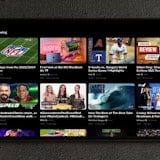 The Samsung Galaxy Nexus has the honour of being the first Android 4.0 Ice Cream Sandwich (ICS) device available on the market. As a collaboration between Google and Samsung, the Galaxy Nexus both looks and functions a bit differently than other Samsung-manufactured smartphones we've seen in the past. We took it for a spin to check out its new operating system (OS), as well as wether or not the Galaxy Nexus is worthy of the Android flagship throne.
The Samsung Galaxy Nexus has the honour of being the first Android 4.0 Ice Cream Sandwich (ICS) device available on the market. As a collaboration between Google and Samsung, the Galaxy Nexus both looks and functions a bit differently than other Samsung-manufactured smartphones we've seen in the past. We took it for a spin to check out its new operating system (OS), as well as wether or not the Galaxy Nexus is worthy of the Android flagship throne.
Samsung Galaxy Nexus Design
One of the more immediately distinguishable features of the Galaxy Nexus is its curved-screen design, adopted from its predecessor – The Samsung/Google Nexus S. The curved screen adds an element of subtle class and intrigue to the display, even while dormant, as this is usually an area of smartphone design that sees little in the way of stylistic distinction.
The convex screen is not only for aesthetic purposes; it actually adds noticeably to comfort, both when held against the ear and when kept in the pocket. The curvature is intended to fit more snugly against the side of the face. It doesn't sound like much, but this kind of benefit is definitely noticeable once you have regular contact with it. When kept in the pocket the screen more closely follows the shape of the leg. It's a simple way of bringing some of the benefits a thinner smartphone might, such as creating a less obvious and uncomfortable bulge, without actually decreasing the profile of the device.
The screen itself is quite large and does not actually sport any of the capacitive buttons we've come to expect on Android devices. These buttons are still present in the OS, but are instead displayed on the actual screen, rather than remaining as stagnant and immovable keys below the screen. Now known as "Virtual Buttons" or "Virtual Keys", these new buttons are visible when needed, but can fold away when doing something like watching a movie, which gives you more screen real-estate.
The back plate of the external case has the appearance of that featured on the Galaxy S II. It is plastic, thin and sports a similarly textured pattern. However, unlike on the GS2 the Galaxy Nexus' rear chassis has been treated with a soft-touch material that increases grip. This is a great addition and we hope to see it on more Samsung devices moving forward.
 Display and User Interface
Display and User Interface
The 4.65 inch 720p display on the Galaxy Nexus is fantastic. The size, coupled with impressive 720x280 resolution, makes for an engaging experience no matter what you're doing. The seemingly idiosyncratic size of 4.65' is to allow for a 16:9 aspect ratio; the same ratio that is used by most modern wide-screen televisions.
An aspect ratio of 16:9 means no more black bars at the top or bottom of the screen when watching a movie or show film in the same ratio, which is generally used as a standard these days. Somehow video content completely filling a screen without any unused areas just feels neater. It really gives the user the feeling that this device was designed with entertainment in mind, rather than as a communication tool that also has media support. It's a small distinction, but it definitely adds to the overall experience in our books.
Color on the display was great. We've seen some folks online get riled up that the display is a Super AMOLED and not a Super AMOLED Plus. But unless we held the Galaxy Nexus next to a Galaxy S II we honestly couldn't tell the difference in color vibrancy. Blacks came out well and whites were relatively crisp.
The 720p resolution was fantastic. A pixel density that approaches an iPhone 4 or 4S retina display on a significantly larger screen really is a treat. The large, clear images lent themselves to everything from standard navigation, to browsing, to images, to apps, to video content. We also had to stifle a few excited nerd giggles that this 4.65 inch display sported the same number of pixels as that 50 inch plasma TV we bought back in '08 and still enjoy today.
Getting Started on the review unit was a bit of an abnormality. The initial setup on the Galaxy Nexus' vanilla ICS system was much faster, but less detailed than we have become accustomed to seeing on Android devices. Setup did not include WiFi, date & time or the syncing of any accounts other than a Gmail account. All of these things were easily enough done post-setup, but we would have preferred prompting to help get them all out of the way in one go. It was at this point when we discovered that the automatic time zone for the Galaxy Nexus was, apparently, GMT+0. We had to manually set the time-zone to Sydney, as well as adjust the date which was 1 day behind due to the originally incorrect time-zone.
We also had an odd issue where the Galaxy Nexus would initially not download anything. Each time we tried to grab an app or update we were greeted with an error and asked to try again later. The problem was fixed by a factory data rest, after which we started again. After which we found that downloading worked fine.
 After the initial hiccups we found the UI to be a smoothly functional experience. The new layout sports some subtle differences in visuals, with a stronger focus on aesthetic style that seems aimed at competing with the quickly popularising Windows Phone operating system (OS). The changes have not been drastic; a new font and higher-resolution icons seem to be at the forefront. We were a bit perplexed by the Google Search bar at the top of every Home Screen. It was not removable and as such ended up feeling like wasted space most of the time. We would have much preferred to see this as a widget that could be confined to one screen, freeing up a whole row for extra apps or extra room for expanding widgets on every other Home Screen.
After the initial hiccups we found the UI to be a smoothly functional experience. The new layout sports some subtle differences in visuals, with a stronger focus on aesthetic style that seems aimed at competing with the quickly popularising Windows Phone operating system (OS). The changes have not been drastic; a new font and higher-resolution icons seem to be at the forefront. We were a bit perplexed by the Google Search bar at the top of every Home Screen. It was not removable and as such ended up feeling like wasted space most of the time. We would have much preferred to see this as a widget that could be confined to one screen, freeing up a whole row for extra apps or extra room for expanding widgets on every other Home Screen.
There is now the helpful option of resizing widgets, which adds an extra element of customization that we really appreciated. Of course, not all widgets are resizable yet, as it is up to the developer to include as part of the programming. However, moving forward it is a function that we expect to see increase in application across the board.
The Applications menu has been split in to two areas: Applications and Widgets. Considering the new focus on fitting multiple widgets on one page in ICS we think this was a wise move. It's handy being able to see any and all widgets that come preloaded on a device, as well as having ready access to any new widgets that have been recently downloaded.
A nice and somewhat late addition is the ability to take screenshots. It's true that some Android devices have been able to take screenshots in the past, but it's never been standard across the OS. Now, by pressing the down-volume and lock button at the same time till take a screenshot. However, if you're even slightly off you'll either lock your screen or take a screen image with the volume-adjustment bar prominently displayed near the top of the screen.
One particular area of note with the vanilla ICS UI is the three virtual buttons. The fact that they peel away when not in use, while cool, is not so much a cause for mention as is the fact that they are no longer the Back, Home and Menu buttons that we have become accustomed to. Instead the buttons are Back, Home and Multitasking. The Multitasking button provides the user with a graphical menu that slides vertically. Each application has its own medium-sized thumbnail. This is a very easy way of switching between applications, however, it takes a bit of getting used to for a practiced Android user.
Android has never been a particularly intuitive OS when it comes to navigation. It's not impossible, but it's definitely not as easy to just pick up and use as iOS or Windows Phone, in the opinion of many people. Taking a system that has taken some people a long time to finally become 100% comfortable with and shaking it up almost feels rude.
However, the menu button is still there in situations where you might need it. Neatly tucked away down in the bottom-right or top-right of the screen is a small ellipsis, or '…'. This small symbol is the new icon for the Menu button. It took us a while to both locate and identify, but once you know what to look for it's easy enough to locate and utilize.
All up we'd have to say we're fans of the new UI controls. But be warned, they definitely take some getting used to if you're accustomed to a more traditional Android layout.
 Web Browsing & Keyboard
Web Browsing & Keyboard
The web browser on the Galaxy Nexus is very fast. Despite common rumor, it's not Google Chrome Mobile; it's still just the standard Android browser. However, much like with the Chrome Mobile beta there was a distinct lack of Adobe Flash support on the Galaxy Nexus. The update will be rolling out eventually to all G-Nex users, but it could take some time. Chrome Mobile, on the other hand, will apparently not be receiving any such servicing.
The large screen lent itself superbly to browsing. Due to the high resolution images and text were extremely clear. Pinch-to-zoom could occasionally become a bit jerky but other than this and the lack of Flash support we had no real issues.
The keyboard was fast and very responsive. However, it lacked certain a certain functionality that we have become very used to seeing on Android handsets. On most devices running Android each key on the keypad has a corresponding symbol that can be access by simply holding that key down for longer than normal. The vanilla ICS keyboard on the Galaxy Nexus had a few options, but not nearly as many as we would have liked. We found ourselves having to hit the Symbol key to open a new keyboard layout, rather than merely holding our finger down then continuing on as per usual. This was a curious omission and we can't say we were fans.
We were also somewhat saddened by the lack of on-board Swype support. Most Samsung handsets come with the useful keyboard mode pre-installed. Swype is definitely not a tool for everyone, but those who use it often tend to get used to it. As a result it is sorely missed when found absent.
Both these complaints in mind we still found the keyboard on the G-Nexus to be more than adequate; we merely think it could have been improved upon by looking to some pre-existing Android keyboards for inspiration.
 Apps and Media on the Samsung Galaxy Nexus
Apps and Media on the Samsung Galaxy Nexus
The dual-core 1.5GHz processor on the Galaxy Nexus lends itself well to running applications and games. Backed up by 1GB of RAM, opening and closing software works smoothly and efficiently, even when running several apps in the background.
When running a game the 3 virtual buttons peel away to give more space for the user. It's a nice touch and the buttons can be easily accessed again by tapping the screen near where they should appear.
The same holds true for video, although the impact is far greater here. As we said before, watching video content and having it fill the 16:9 screen all the way to the edges is a satisfying experience. It's often the small touches in a mobile UI that can really take it from being a pleasant, to a really smooth experience.
The music player has seen an aesthetic overhaul, but functions very much similarly to how it always has. Considering that we've always found the Android music player to be a capable and adequate application, a visual makeover is all we really would have asked for in ICS. On the theme that a picture's worth a thousand words we've utilized the new screenshot function so that you can see for yourself.
Camera
The 8MP camera on the Samsung Galaxy Nexus is great. Shots in well-lit situations came out fantastically and it even seemed to handle low-lit areas a bit better than some other Android and Samsung devices we've tested, such as the Galaxy S II.
The camera is also capable of taking shots in extremely rapid succession. It's not exactly the 'zero' shutter time that Samsung and Google have pegged it as being, but it's definitely capable of snapping off more than one pic per second. When taking a succession of photos we found that every once in a while one would come out particularly blurry, but the greater percentage didn't seem to suffer.
The 1080p video capture is very good but still not really worth the title of '1080p'. What we mean by that is that the handset is capable of some impressive filming when compared to other handsets, but it's definitely not going to come out as clear as a blu-ray on a 1080p full-HD TV set. There's also a fair bit of blurring if the handset is moved about too quickly while filming, but that's something we've seen on every device we've ever reviewed.
 Battery Power
Battery Power
Battery power is surprisingly good on the Galaxy Nexus considering its powerful CPU and large display. We easily got a full day's use out of the device at medium usage. Heavier use tended to push the battery a bit, but after we removed some superfluous widgets from the Home Screen we made it through a full day without losing charge easily.
Of course 3G and Video services strained the relationship a bit, but we found it to be no more a problem than on any other handset.
The WhistleOut Opinion
The Samsung Galaxy Nexus is definitely one of our favorite devices out on the market right now. As far as Androids go we'd put it up there with the Galaxy S II and the HTC Sensation XL, both of which we were huge fans of.
The large, crisp screen is fantastic for consuming video content, browsing and reading. The new ICS UI is responsive and fast, even if it does take a bit of getting used to. The new aesthetics are also a nice touch and we felt a bit reassured that Android wasn't falling behind in the OS game when it came to style.
The phone might be large, but due to its curved shape we found that it didn't cause any discomfort in the pocket. It's not the sexiest design for a phone that we've ever seen, but it's certainly not ugly either.
The camera functioned well, apps worked smoothly and the new ability to resize widgets was fantastic. Overall we would definitely recommend the Samsung Galaxy Nexus to anyone in the market for a new high-end device, especially one with a larger screen.
Compare Galaxy Nexus Prices, Plans and Deals



Related Articles
Find Better Phones and Plans
Hundreds of cell phone plans unpacked. All the facts. No surprises.



































